Dental hygiene introduces foundational concepts essential for maintaining oral health‚ focusing on preventive measures and disease prevention. It emphasizes proper techniques for patient care and hygiene practices.
Overview of Dental Hygiene
Dental hygiene encompasses the study and practice of maintaining oral health through preventive measures and patient education. It focuses on disease prevention‚ proper oral care techniques‚ and the promotion of healthy habits. This field includes clinical procedures such as plaque control‚ periodontal therapy‚ and oral health assessments. Dental hygiene also involves understanding dental anatomy‚ tooth morphology‚ and the latest techniques in patient care. The goal is to equip students with the knowledge and skills needed to provide effective oral health services‚ emphasizing the importance of hygiene in preventing dental and systemic diseases.
Importance of Dental Hygiene
Dental hygiene is crucial for preventing oral diseases and promoting overall health. Proper hygiene practices‚ such as regular cleanings and plaque control‚ help prevent conditions like gingivitis and periodontitis. Additionally‚ good oral health is linked to systemic well-being‚ reducing risks of heart disease and diabetes. Dental hygiene also enhances patient confidence and quality of life by maintaining functional and aesthetically pleasing teeth. Regular hygiene practices‚ combined with patient education‚ are key to long-term oral health management and disease prevention. Understanding these principles is essential for effective dental care delivery in clinical settings.

Dental Anatomy
Dental Anatomy covers tooth morphology‚ histology‚ and supporting structures‚ essential for understanding oral function and hygiene practices in dental care.
Tooth Morphology
Tooth morphology studies the shape‚ structure‚ and function of teeth‚ essential for dental hygiene practices. It examines enamel‚ dentin‚ cementum‚ and pulp‚ focusing on their roles in oral health. Understanding tooth anatomy helps hygiene professionals identify normal and abnormal structures‚ aiding in accurate assessments and treatments. This knowledge is crucial for effective cleaning techniques‚ patient education‚ and maintaining proper oral hygiene. Morphology also covers variations in tooth types‚ such as incisors‚ canines‚ premolars‚ and molars‚ each with unique functions and care requirements. This foundational understanding supports preventive and therapeutic dental hygiene interventions‚ ensuring optimal patient care outcomes.
Dental Histology
Dental histology examines the microscopic structure of teeth and surrounding tissues‚ focusing on enamel‚ dentin‚ cementum‚ and pulp. Enamel‚ the hardest substance‚ is formed by ameloblasts‚ while dentin‚ beneath it‚ is produced by odontoblasts. Cementum covers roots‚ aiding tooth anchorage‚ and pulp contains nerves‚ blood vessels‚ and cells vital for tooth health. Understanding these tissues’ composition and function is crucial for diagnosing conditions like decay or pulpitis. Histology also explores periodontal tissues‚ such as gingiva‚ periodontal ligament‚ and alveolar bone‚ which support teeth and maintain oral health. This knowledge aids hygienists in assessing and treating diseases effectively.
Supporting Structures of the Teeth
The supporting structures of the teeth include the periodontium‚ which comprises the gingiva‚ periodontal ligament‚ cementum‚ and alveolar bone. The gingiva‚ or gums‚ surrounds the teeth‚ protecting them from bacterial invasion. The periodontal ligament connects the tooth root to the alveolar bone‚ absorbing chewing forces. Cementum covers the root surface‚ aiding in tooth anchorage. The alveolar bone forms the tooth socket‚ providing a stable base. Together‚ these structures ensure proper tooth alignment‚ stability‚ and function. Maintaining their health is vital for preventing conditions like periodontitis‚ which can lead to tooth loss if left untreated.
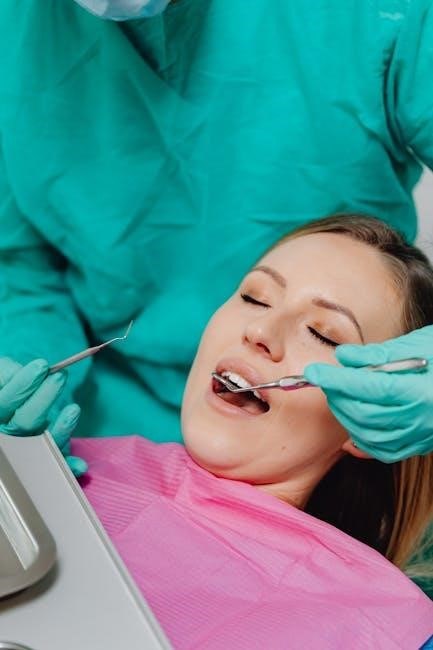
Infection Control in Dentistry
Infection control in dentistry involves practices to prevent the spread of infectious diseases. Key measures include hand hygiene‚ use of personal protective equipment‚ and proper sterilization of instruments. Protocols ensure a safe environment for both patients and dental professionals‚ minimizing risks during procedures.
Hand Hygiene Practices
Hand hygiene is a critical component of infection control in dentistry. Dental professionals must wash hands with soap and water or use alcohol-based hand sanitizers before and after patient interactions. Proper technique includes scrubbing all surfaces of the hands for at least 20 seconds. Hand hygiene should be performed before donning gloves‚ after removing gloves‚ and between patient contacts. Fingernails should be kept short and clean‚ and jewelry minimized to reduce microbial harborage. These practices significantly reduce the risk of cross-contamination and ensure a safer environment for both patients and healthcare providers.
Sterilization and Disinfection Methods
Sterilization and disinfection are essential for maintaining asepsis in dental settings. Autoclaving‚ using high-pressure steam‚ is the most reliable method for sterilizing instruments. Dry heat sterilization is an alternative for heat-stable items. Chemical disinfectants‚ such as glutaraldehyde‚ are used for surfaces and equipment that cannot be autoclaved. Ultraviolet (UV) light disinfection is another option‚ though it is less effective. Proper protocols ensure all instruments and surfaces are treated appropriately to prevent infection transmission. These methods are critical for patient safety and compliance with dental hygiene standards.
Personal Protective Equipment (PPE)
Personal Protective Equipment (PPE) is crucial in dental settings to prevent the transmission of infectious agents. Common PPE includes gloves‚ masks‚ eye protection‚ and gowns. Gloves prevent skin contact with pathogens‚ while masks reduce the inhalation of airborne contaminants. Eye protection‚ such as goggles or face shields‚ safeguards against splashes and spills. Gowns protect clothing from contamination. Proper donning and doffing of PPE are essential to avoid cross-contamination. Adhering to PPE protocols ensures the safety of both patients and dental professionals‚ maintaining a sterile environment during procedures.

Patient Assessment
Patient assessment is a critical step in dental care‚ involving evaluation of medical history‚ clinical examination‚ and documentation to guide personalized treatment plans and ensure safety.
Clinical Examination Techniques
Clinical examination techniques involve a thorough inspection of the oral cavity to assess dental health. This includes visual inspection of teeth‚ gums‚ and surrounding tissues to detect signs of decay‚ gum disease‚ or abnormalities. Periodontal probing measures pocket depths to evaluate gum health‚ while radiographic analysis provides insights into underlying structures. Proper use of dental mirrors and probes ensures accurate assessments. These methods help identify plaque‚ calculus‚ and other factors impacting oral health‚ guiding personalized treatment plans and preventive care strategies.
Medical History Evaluation
Medical history evaluation is crucial for understanding a patient’s overall health and its impact on dental care. It involves reviewing medical conditions‚ medications‚ allergies‚ and lifestyle factors. This assessment helps identify systemic diseases that may influence oral health‚ such as diabetes or heart conditions. Accurate documentation ensures personalized treatment plans‚ avoiding potential complications. It also reveals any contraindications for procedures or medications. Regular updates to the medical history are essential‚ as changes in health status can affect dental hygiene practices. This step ensures safe and effective care‚ promoting patient well-being and minimizing risks.
Dental Charting and Documentation
Dental charting and documentation are essential for recording a patient’s oral health status. This process involves noting the condition of teeth‚ gums‚ and surrounding tissues‚ including plaque‚ tartar‚ and signs of periodontal disease. Accurate documentation ensures continuity of care and legal protection. Standardized symbols and codes are used to represent findings‚ such as tooth mobility or furcation involvement. Detailed records also include radiographic findings and treatment plans. Regular updates ensure comprehensive tracking of changes over time. Proper documentation supports effective communication among healthcare providers and enhances patient outcomes; It is a critical component of dental hygiene practice.
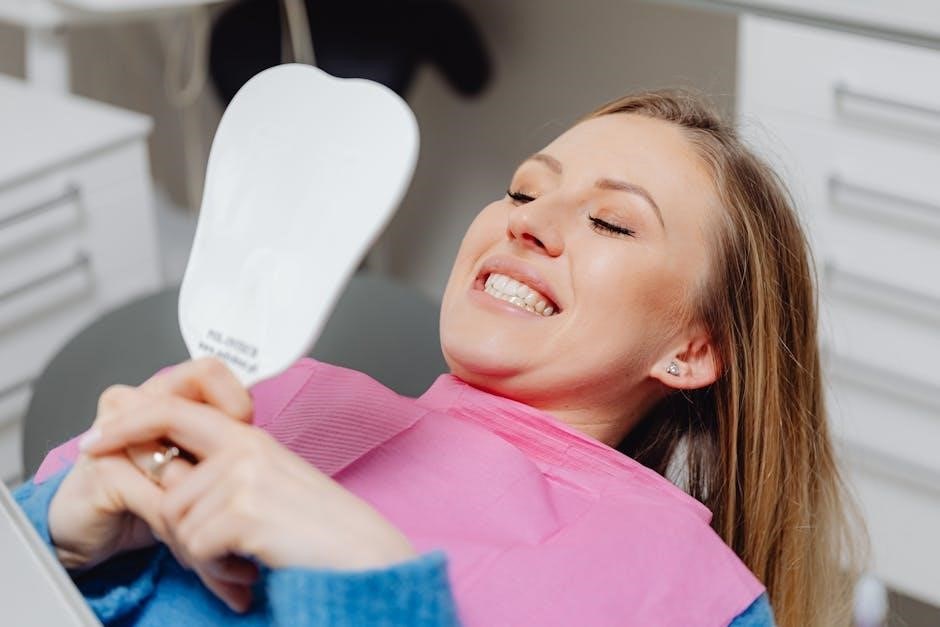
Preventive Dental Measures
Preventive dental measures focus on educating patients on oral health practices‚ promoting regular cleanings‚ and applying protective treatments like fluoride to prevent decay and disease.
Oral Hygiene Instructions
Effective oral hygiene instructions guide patients on proper brushing and flossing techniques to remove plaque and prevent gingivitis. Emphasize brushing twice daily with fluoride toothpaste.
Demonstrate correct brushing angles and gentle pressure to avoid gum damage. Recommend interdental cleaning with floss or interdental brushes for areas toothbrushes cannot reach.
Instruct patients to replace toothbrushes every 3-4 months and ensure proper toothpaste usage. Tailor advice to individual needs‚ such as orthodontic or implant care.
Encourage regular dental checkups for early detection of oral issues‚ promoting a proactive approach to oral health maintenance.
Fluoride and Sealant Applications
Fluoride applications strengthen tooth enamel‚ preventing decay and sensitivity. They are applied topically in gel or varnish form‚ promoting remineralization.
Dental sealants are protective coatings applied to pits and fissures of molars to prevent bacteria accumulation and cavities. They are most effective when applied to newly erupted teeth.
Both treatments are non-invasive and highly effective in preventing dental caries. Fluoride applications are suitable for all ages‚ while sealants are primarily recommended for children and adolescents.
Regular application of these preventive measures significantly reduces the risk of tooth decay and supports long-term oral health.
Nutrition and Diet Counseling
Nutrition plays a crucial role in maintaining oral health. A balanced diet rich in calcium‚ vitamin D‚ and fiber supports tooth and gum health. Foods high in sugar and acids contribute to tooth decay‚ so limiting their consumption is essential. Hydration is also vital for saliva production‚ which helps neutralize acids and remineralize teeth. Dental hygienists often provide personalized diet counseling‚ emphasizing the importance of nutrient-dense foods and healthy eating habits to prevent caries and promote overall well-being. Proper nutrition is a key component of a comprehensive preventive dental care plan.
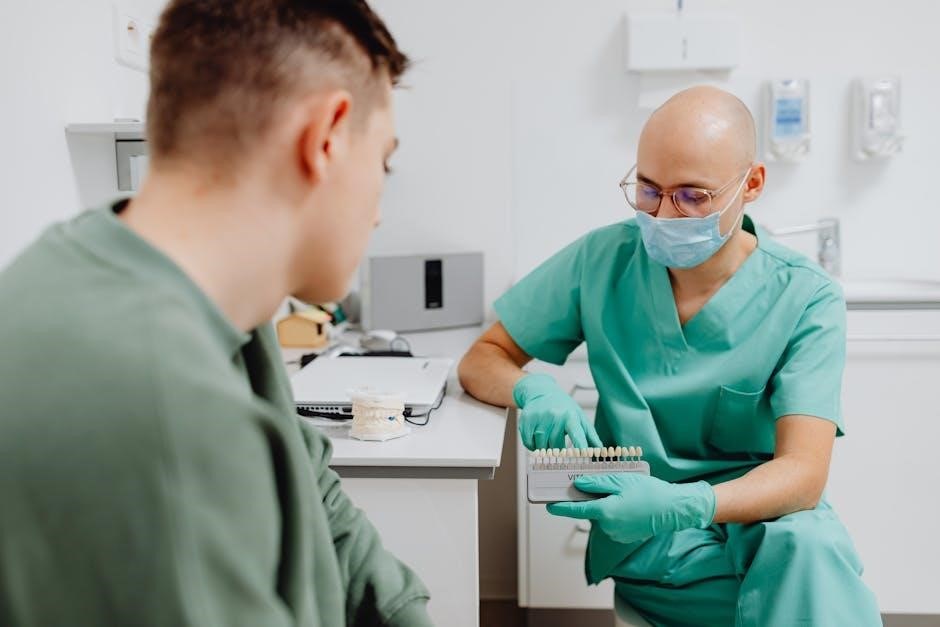
Dental Procedures
Dental procedures include prophylaxis‚ periodontal therapy‚ and restorative treatments. These interventions aim to prevent‚ diagnose‚ and treat dental conditions‚ ensuring optimal oral health and functionality.
Prophylaxis and Routine Cleanings
Prophylaxis and routine cleanings are essential preventive dental procedures. They involve scaling to remove plaque and tartar‚ polishing to smooth tooth surfaces‚ and fluoride treatments to strengthen enamel. These cleanings prevent gingivitis and periodontal disease by eliminating bacteria and irritants. Dental hygienists use ultrasonic or hand instruments for thorough cleaning above and below the gum line. Regular cleanings‚ typically every six months‚ maintain oral health and prevent more invasive treatments. They are a cornerstone of dental hygiene‚ promoting long-term oral wellness and early detection of potential issues.
Periodontal Therapy
Periodontal therapy focuses on treating periodontal disease‚ addressing inflammation and infection of the gums and supporting tissues. It aims to halt disease progression and restore tissue health. Treatment options vary based on disease severity and may include scaling and root planing‚ antimicrobial therapies‚ or surgical interventions like pocket reduction or regenerative procedures. Non-surgical approaches are often first-line treatments‚ while surgery is reserved for advanced cases. Patient compliance with oral hygiene practices is crucial for successful outcomes and long-term periodontal health. Regular follow-ups ensure sustained healing and prevent recurrence.
Restorative Dental Procedures
Restorative dental procedures aim to repair or replace damaged teeth to restore function‚ aesthetics‚ and oral health. Common procedures include fillings‚ crowns‚ bridges‚ and dentures. Fillings address decayed areas‚ while crowns cover severely damaged teeth. Bridges and dentures replace missing teeth‚ improving chewing ability and smile appearance. Materials like composite resin and porcelain are used for durability and natural-looking results. These procedures not only enhance dental functionality but also boost patient confidence by restoring the natural beauty of the smile. Regular maintenance ensures the longevity of restorative work‚ supporting overall oral well-being and patient satisfaction.

Emergency Management
Emergency management in dentistry involves handling medical crises‚ such as cardiac arrests or seizures‚ and traumatic injuries. Immediate response and first aid are critical to patient outcomes.
Medical Emergencies in Dental Settings
Medical emergencies in dental settings require prompt recognition and response. Common issues include syncope‚ hypoglycemia‚ asthma attacks‚ and cardiac arrest. Dental teams must be prepared to handle these situations effectively. Proper training in CPR and the use of emergency drugs is essential. Maintaining an emergency kit with oxygen‚ epinephrine‚ and other medications is critical. Assessment of the patient’s airway‚ breathing‚ and circulation (ABCs) is the first step. Ensuring patient safety and stabilizing vital signs are priorities. Communication and teamwork between dental staff are vital to manage these crises efficiently and prevent complications. Regular drills and updates on emergency protocols are recommended.
Managing Traumatic Injuries
Traumatic injuries in dental settings require immediate and careful management to ensure patient recovery. Common injuries include tooth fractures‚ lacerations‚ and avulsions. Assessment involves evaluating the extent of damage and stabilizing the patient. For dental trauma‚ controlling bleeding with gauze and applying ice to reduce swelling are critical. In cases of tooth avulsion‚ prompt reimplantation or storage in milk or saline is essential. Proper documentation and follow-up care are vital to monitor healing. Referral to a specialist may be necessary for complex cases. Ensuring patient comfort and preventing infection are key priorities in managing traumatic injuries effectively.
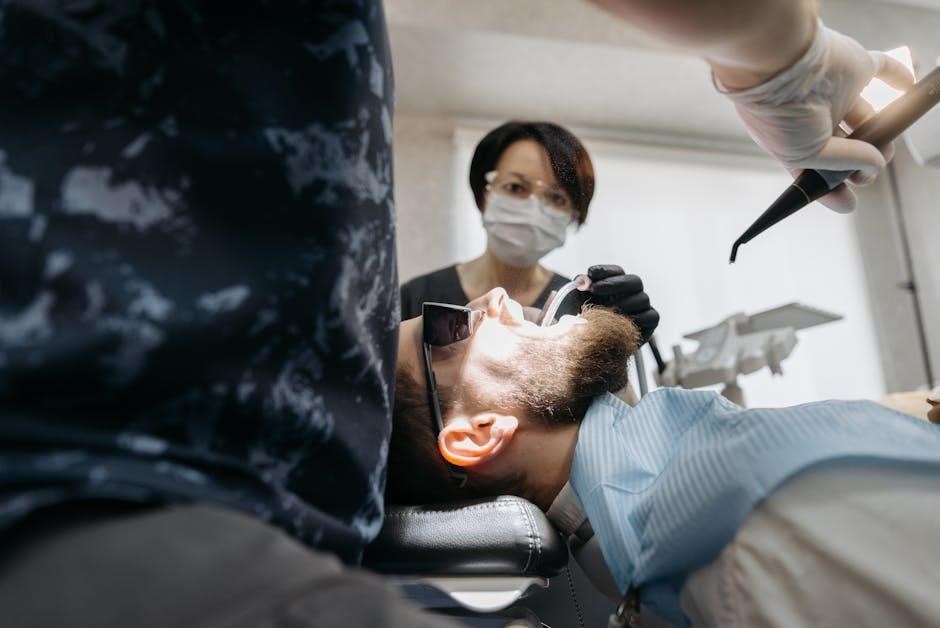
Current Concepts in Dental Hygiene
Modern dental hygiene emphasizes personalized treatment plans‚ preventive care‚ and advanced technologies to improve oral health outcomes and patient satisfaction.
Dental Implants and Their Care
Dental implants are artificial tooth roots used to support restorations like crowns or bridges. Proper care is essential for longevity‚ involving daily brushing‚ flossing‚ and interdental cleaning. Regular dental check-ups ensure implant stability and prevent complications like peri-implantitis. Patients should avoid smoking‚ as it increases failure risk. A balanced diet supports healing and implant integration. Hygienists play a key role in educating patients on maintenance techniques and monitoring implant health during routine visits. Advances in implant design and surfaces improve success rates‚ making them a reliable option for tooth replacement.
Advancements in Dental Hygiene Practices
Recent advancements in dental hygiene practices include the use of laser technology for precise plaque removal and gum therapy. Ultrasonic devices now offer deeper cleaning with less discomfort. Air polishing has become a popular method for effectively removing stains and plaque. Additionally‚ advancements in whitening techniques and enamel-friendly materials improve aesthetic outcomes. Digital tools like intraoral cameras and diagnostic software aid in early detection of oral issues. Biocompatible materials are reducing sensitivities and improving patient comfort. These innovations enhance treatment efficacy‚ patient satisfaction‚ and overall oral health outcomes‚ making dental hygiene more personalized and effective than ever before.
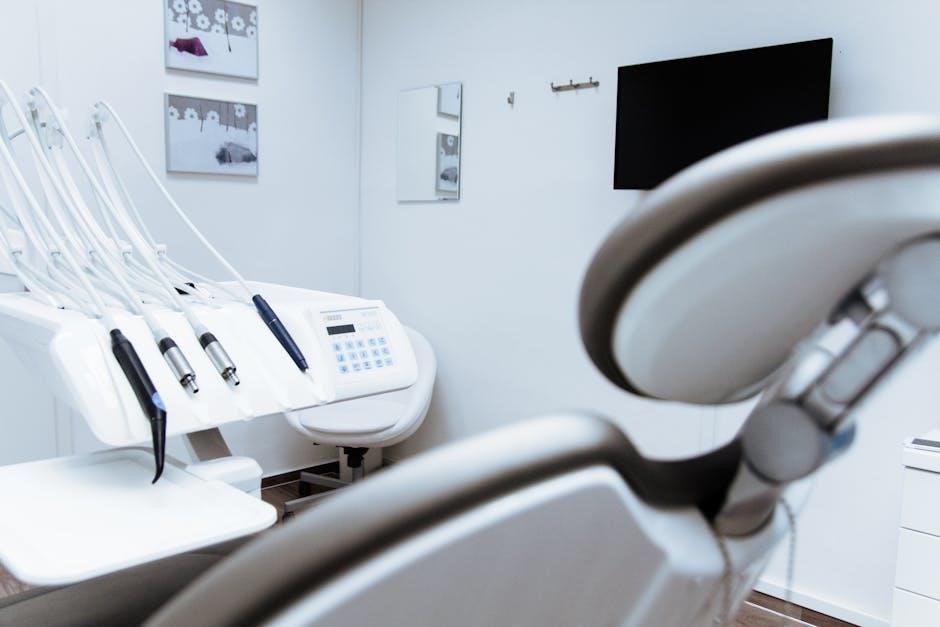
Legal and Ethical Considerations
Compliance with dental laws‚ regulations‚ and ethical standards ensures patient rights and safety. Maintaining confidentiality‚ obtaining informed consent‚ and upholding professional integrity are essential in dental hygiene practice.
Compliance with Dental Regulations
Compliance with dental regulations is crucial for ensuring patient safety and legal practice. Dental hygienists must adhere to laws governing infection control‚ patient privacy‚ and record-keeping. Regulations‚ such as OSHA guidelines for infection control and HIPAA for patient confidentiality‚ must be strictly followed. Proper documentation of treatments and patient interactions is essential for legal protection and accountability. Staying informed about updates in dental laws and standards ensures ongoing compliance. Violations can result in legal consequences‚ emphasizing the importance of understanding and adhering to all applicable regulations in dental hygiene practice.
Patient Confidentiality and Ethics
Patient confidentiality and ethics are cornerstone principles in dental hygiene practice. Dental hygienists must safeguard patient health information in accordance with laws like HIPAA. Confidentiality extends to all forms of communication‚ ensuring trust and professionalism. Ethical dilemmas may arise‚ requiring hygienists to uphold integrity and respect patient autonomy. Maintaining clear boundaries and avoiding conflicts of interest are vital. Breaches of confidentiality or ethical misconduct can damage patient trust and lead to legal repercussions. Adhering to ethical guidelines fosters a respectful and trustworthy relationship between providers and patients‚ ensuring quality care and compliance with professional standards.
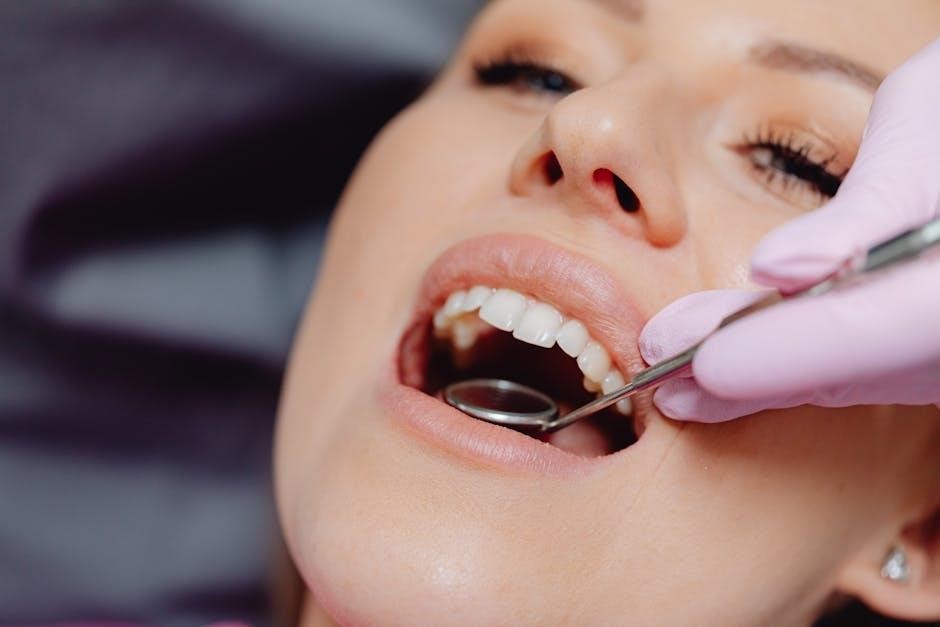
Study Tips and Resources
Master dental hygiene with active recall and spaced repetition for better retention. Utilize online platforms and dental association resources. The Dental Hygiene Educators Association offers valuable study aids.
Effective Study Strategies
To excel in dental hygiene studies‚ adopt active learning techniques such as self-quizzing and flashcards. Organize study groups to discuss complex topics like anatomy and infection control. Use visual aids like diagrams and videos to reinforce concepts. Break study sessions into manageable chunks‚ focusing on one topic at a time. Set realistic goals and track progress. Practice case studies to apply theoretical knowledge. Regularly review notes and textbooks‚ highlighting key points. Utilize online resources and apps for interactive learning. Stay consistent and avoid cramming for better retention of dental hygiene principles and procedures.
Recommended Textbooks and Resources
Essential textbooks for dental hygiene studies include “Clinical Practice of the Dental Hygienist” and “Dental Hygiene: Theory and Practice”. Online resources like the American Dental Association (ADA) and National Board Dental Hygiene Examination (NBDHE) websites provide valuable practice materials. Utilize apps like Dental Hygiene Pro for interactive learning. Journals such as the Journal of Dental Hygiene and International Journal of Dental Hygiene offer updated research. Supplement studies with video tutorials from platforms like YouTube and Coursera. These resources ensure comprehensive preparation for both academic and clinical success in dental hygiene education.